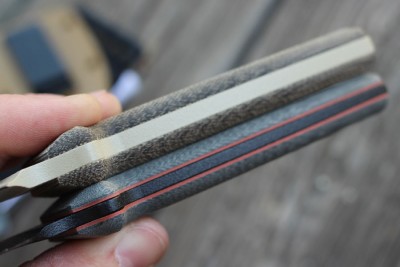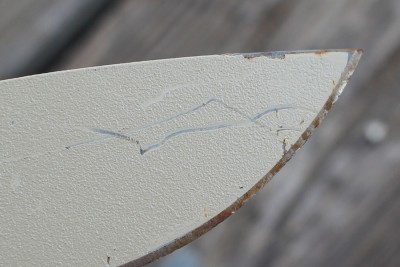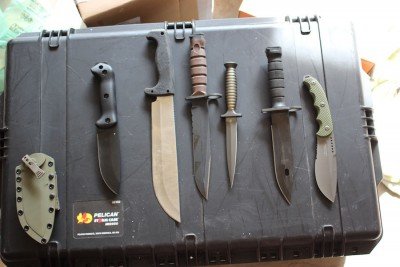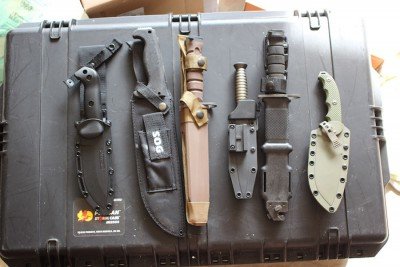We here at GunsAmerica can get pretty passionate about the blades in our pockets or on our hips. And why should that be a surprise? Our knives are utilitarian tools and backup defensive weapons. I’ve been carrying a gun for years, but I grew up with knives. I began EDC of a pocket knife when I earned the rank of Eagle Scout at age 13. I didn’t give a shit that my middle school and high school didn’t allow knives. I simply kept it concealed and stayed out of trouble.
As a devotee of all things cutting edge, I really enjoy knife reviews. But to what end? Odds are very few of us will ever take a fixed blade knife to the point of failure. And the nicest knives on the market these days cost more than some guns, and even though they’re built to withstand the Apocalypse, they never leave their original boxes, and stay safely tucked up in the safe.
Well to hell with the safe queens. We’re on a quest for an honest working knife–a one blade solution to a lot of typical knife issues. I began the work for this last year, with a preliminary list of contenders. The tests were hardly scientific. Even so, I’ve eliminated almost all of the ones on the first list.
But first, the backstory
In our original post, I talked about a Marine and his experience with big knives. I’ll sum it up here; big knives are heavy. Heavy is bad when you carry your own gear. Big, heavy knives get tossed aside. If that was the only knife you had, you’re naked. And worse, someone else (perhaps an enemy) will pick it up.
I wanted to try it out, anyhow–so I put a couple of my favorite big knives in the mix. These were the knives I had on hand to work with. Like these two:
[full_width]
[/full_width]
OKC makes great knives. This one is ideal for camp work. There’s a lot of blade to work with. And, as big knives go, it isn’t as heavy as it could be. This one is my current go-to in the truck. It is on the side of the bag I only carry from the house to the truck to the cabin, etc.
[full_width]
[/full_width]
Bark River makes some exquisite blades. There are serious collectors, too, that would hyperventilate when they see I’ve removed this one from its original box. I’ve even used this one as I would–gasp–an ax. And it works great. But damn, is this thing heavy.
The results of the big knife theory? They chop exceptionally well. They are easy to see, visually, and very intimidating. Their width allows for them to withstand a ton of abuse. And an exceptionally well-tempered blade is all but indestructible. But they’re heavy. They are, for almost everything you do in the woods, overkill. And even when chopping–the one thing that they truly do well–they don’t chop as well as a good hatchet or a sharp machete.
So why are there so many devoted fans of giant fixed blade knives? I called up Jacob Epstein, GunsAmerica’s Tactical Editor, and I asked him about a knife I’d seen on his vest–a monster Fox Tactical behemoth that weighed more than three pounds.
“Yeah,” he said, laughing. “I sold it.” Epstein had figured it out, too, just from basic training work at the range. Bigger isn’t always better. What’s the equivalent in the gun world? There are obvious parallels. I know a lot of folks who have bought guns that were too big to carry concealed–even though that was the reason why they bought the gun in the first place. It stays at home, or in the car, and isn’t there when needed.
The original line-up.
[one_half]
[/one_half][one_half_last]
[/one_half_last]
As it turned out, when I began this quest, I didn’t have a medium sized fixed blade that wasn’t in service in the kitchen. I had several knives in the 7″ range (like the old Ka-Bar). And I was able to beg and borrow these, with an eye toward testing.
From left to right, the knives:
1. Ka-Bar Becker BK-10. This knife is heavier than most, but exceptionally well balanced. There’s a cult following that has developed around this knife. I picked this one up at the Blade Show last year. It is a cosmetic blemish but works exceptionally well. This is the one knife from this line-up that has made it into the second phase of testing. $117.
2. SOG Jungle Cutlas. This is a kick-ass heavy chopper. And for car camping, or tasks around the cabin, the rubber handle and stainless blade make this a true workhorse. I dearly love the knife, but I’m not going to carry it far if I have to carry my own gear. It isn’t a hiking knife. $70.
3. Ontario OKC 3s Bayonet. Is the bayonet anachronistic? I asked for this one early because I’d hoped to see something in the American issued gear that seemed logical and would support the large knife. There is a belief held by some knife designers, that the blade of a fighting knife needs to be 7″ long to strike vital organs in humans. To that end, this works. But I don’t even own a rifle that can take a bayonet anymore. And if I can’t put it on a gun, it is a knife–not a bayonet. $184.
4. Browning Black Label Rail System Knife. The pig sticker design is great for sticking small pigs. And The Fairbairn-Sykes design is a great second knife. But the tang is weak, there’s no heft to the blade, while it is optimal for stabbing, it doesn’t do anything else. Actually, that’s not true. This knife’s sheath is designed to attach to a piccatinny rail. It does that exceptionally well, if that’s something you’re looking for. But for our purposes here, I’ve scratched it off the list. Price? $74 or so, retail. Hard to find this one anymore.
5. Ontario M9 Bayonet. So if one updated Ontario bayonet doesn’t make the list, odds are the older design won’t either. Again, I’m enamored with the design. I like the feel of the knife. If you were in need of a functional knife, this would work. Yet it has features that simply aren’t useful for my set of criteria. It does have a wire-fence cutter, though, that kicks ass. $172.
6. Browning Black Label Committed. The second Browning knife was included more for its simplicity and price. It has a great sheath–possibly my favorite part of the design. The blade itself is deeply hollow-ground, and it has a serrated edge. Is that good? As long as it stays sharp. Compared to sharpening a flat edge, serrations can be a hassle. In the end, I am putting this on the reserve list. $97.
The refined criteria
After more than six months of focused examination, I’ve made some decisions. Here’s what I’m looking for. I want the perfect knife to put on a tactical vest. I’d like to know that the same knife would be equally at home on my belt, if I were in the shop or out hunting. I’m not looking at any pocket knives for this list–I’ve never seen a pocket knife that’s capable of the abuse you can put good fixed blades through. I’m not saying I don’t like pocket knives–as I mentioned, I’m never without one–but I want something more. So the knife has to be all of these things:
- Fixed Blade
- Appropriate for basic bush-craft
- Capable of fighting
- Not too long (The traditional fighting knife has a 7″ blade)
- Not too short (At least 3″ of blade)
- Not too heavy (This one gets subjective)
- Full tang (for durability of the blade and handle)
- Not delicate in any way
- Readily available
- Easy to clean and sanitize
- Capable of standing up to weather, use, and abuse.
I’m considering several brands, already. I’ve got knives from a variety of price-points. Some of these are fan favorites, and some are more obscure. Ideally, I’d like to support America labor but when we get into pricing, we may make some allowances.
The new short list
[full_width]
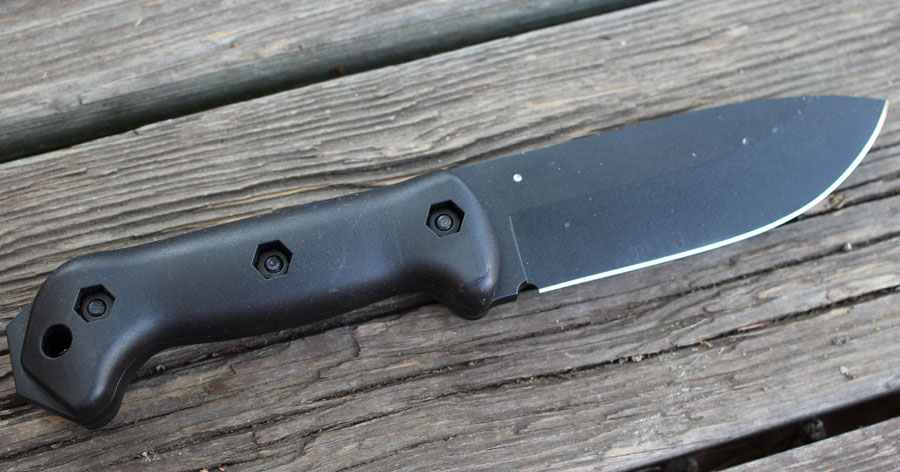
The Becker is still in the running.
[/full_width]
The strength of the Becker? It has a compact design with a fat blade. Excellent strength. And a huge cult following means there are a lot of available modifications. We’ll be looking at how the blade arrives from Ka-Bar, and what the every one does to it. This is the AR-15 of the knife world.
[full_width]

I’ve added the 4″ Esee.
[/full_width]
The Esee knives have an equally devoted fan base. They are thinner and more nimble than the Beckers. If you are looking for the ideal balance between weight and performance, this might be it.
[full_width]

The Committed is still on the list.
[/full_width]
For those who like a combination blade, and one that has a fat belly for skinning and such, the Committed is a decent option. The grip is also very easy to hold onto thanks to the finger groves. I like the sheath it comes with, too.
[full_width]

This Morakniv is a great option, and a real value, too.
[/full_width]
A friend bought me this knife a few years ago, and it sees regular service in my kitchen. I love the Scandi grind on the blade. It is exceptionally sharp and has stood up to regular trips through the dishwasher. And it is stupid cheap. I’ve yet to see inside the handle, though, so I’m not sure about strength.
[full_width]

What would the knife look like if I had it designed from the ground up? Fall Creek Knives is here to answer that question.
[/full_width]
As I began to narrow down my list of criteria, I talked with several custom knife makers about the concept. I’ve made knives myself, both by means of forging and stock reduction, so I’m not clueless when it comes to metallurgy and technique. I’m also not an expert, so I figured I’d talk to one. Shannon Carter at Fall Creek Knives was kind enough to answer my questions and he’s worked with me on this pair above–the customized answer to the question. Stay tuned for the complete review.
And this is where you come in. Look at my list above and make some suggestions. This is an ongoing project. What knives should make the short list? What would you expect a general purpose knife to be able to do? Respond in the comments below.
Want to read more about the folders we’ve been working out, click here.
